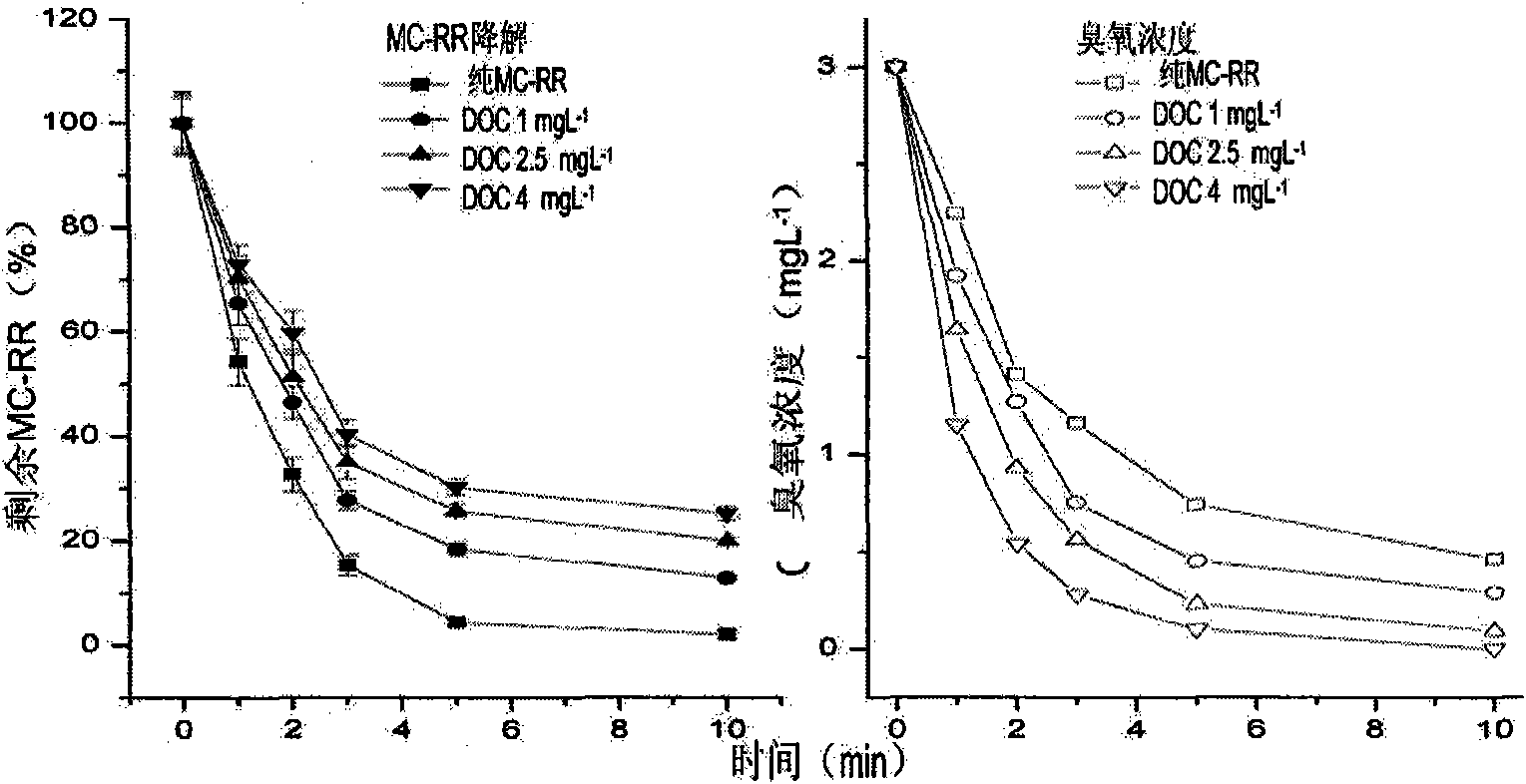Method of removing and purifying microcystin in drinking water
A microcystin and drinking water technology, applied in the field of water treatment, can solve the problems of decreased toxicological safety and insufficient removal capacity of dissolved pollutants, and achieve high industrial application prospects, strong removal pertinence, and toxicological safety sex high effect
- Summary
- Abstract
- Description
- Claims
- Application Information
AI Technical Summary
Problems solved by technology
Method used
Image
Examples
Embodiment 1
[0024] Influence of Liquid Phase Ozone Concentration on Advanced Treatment of Raw Water
[0025] From figure 2 It can be seen that the removal rate of algae toxins increases with the increase of liquid phase ozone dosage. Under the same conditions, MC-LR has a removal rate of 80.3% for MC-LR at a reaction temperature of 25°C, a pH of 7.0, a reaction time of 30 min, and a liquid phase ozone concentration of 1 mg / L. The removal rate of MC-RR It was 77.6%; when the ozone concentration was increased to 3mg / L, the removal rate of MC-LR was 90.3%, and the removal rate of MC-RR was 85.7%; when the ozone concentration was increased to 5mg / L, the removal rate of MC-LR The rate is 95.7%, and the removal rate of MC-RR is 89.3%. In fact, the whole reaction is a fast and then slow process in the process of removing algae toxins. Taking 5mg / L ozone concentration as an example, the removal efficiency of MC-LR has reached 94.4% in the first 10 minutes of the reaction, and MC-RR The remova...
Embodiment 2
[0028] Effect of DOC on removal of algal toxins
[0029] Since there will inevitably be a lot of organic matter in surface water, the study of the effect of organic matter on the degradation of algal toxins is also very necessary. Taking humic acid with relatively large background content in water as a representative organic matter, the removal efficiency of ozone on algal toxins under different DOC concentrations was investigated. In the research on the influence of DOC, because there is a certain amount of organic interference in the algae culture concentration, the concentration of the amount of DOC added in the research process changes, so the present invention uses the extracted pure algae toxin as the research target. image 3 It shows the effect of different initial DOC concentrations on the degradation of algae toxins under the condition of ozone concentration of 3mg / L. With the increase of DOC concentration in the solution system, the degradation rate and efficiency o...
Embodiment 3
[0031] Free radical scavengers (NaHCO 3 ) on the removal of algal toxins
[0032] The removal of organic matter in water by ozone is the result of two different pathways: direct attack of ozone molecules and indirect free radical reaction. A certain amount of carbonate (CO 3 2- ) and bicarbonate (HCO 3 - ) ions, and these ions (mainly bicarbonate) are typical free radical inhibitors, they can capture the OH produced by ozone, thereby blocking the indirect reaction pathway of ozonation reaction and affecting the removal of organic matter in water by ozonation reaction Effect. The invention investigates the influence of bicarbonate ions in water body on the ozonated algae toxin. As shown in Table 1, free radical scavengers (NaHCO 3 ) will significantly reduce the removal efficiency of algal toxins. Therefore, NaHCO in water should be reduced as much as possible. 3 content in order to improve the removal effect of algal toxins
[0033] Table 1 The effect of free radical...
PUM
 Login to View More
Login to View More Abstract
Description
Claims
Application Information
 Login to View More
Login to View More - R&D
- Intellectual Property
- Life Sciences
- Materials
- Tech Scout
- Unparalleled Data Quality
- Higher Quality Content
- 60% Fewer Hallucinations
Browse by: Latest US Patents, China's latest patents, Technical Efficacy Thesaurus, Application Domain, Technology Topic, Popular Technical Reports.
© 2025 PatSnap. All rights reserved.Legal|Privacy policy|Modern Slavery Act Transparency Statement|Sitemap|About US| Contact US: help@patsnap.com



